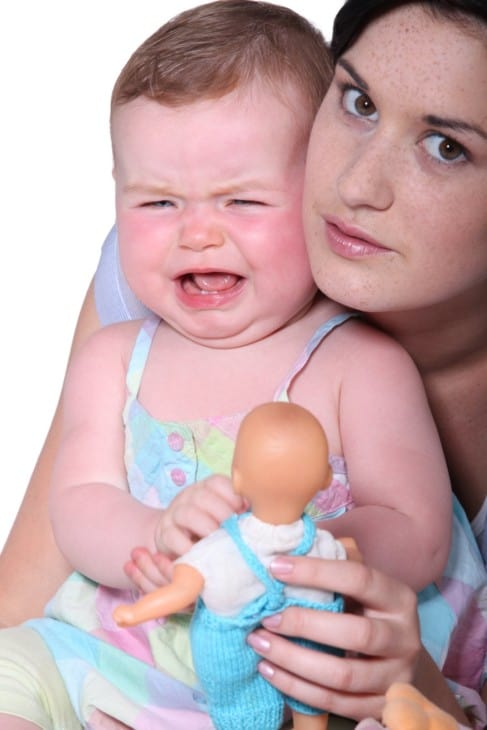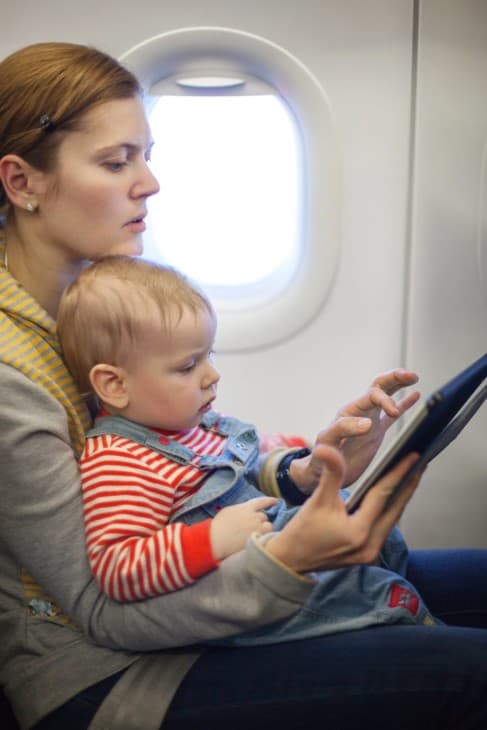Is there anything worse than the sound of a baby screaming and wailing away on an airplane? How about being attached to them as their overwhelmed parent?
Babies cry on airplanes mostly due to cabin pressure pressing down on their fragile ears. Babies’ ears are more sensitive than adults ears, and they are mostly unable to equalize their ears like adults can. Babies also cry for the more mundane reasons such as hunger, cold, or a soiled diaper.
Few things sicken the heart faster than a screaming and crying baby, but when your bouncing bundle of joy starts wailing on a plane, as you attempt to block your ears and the annoyed looks of your fellow passengers, the big question is – why? What can you do about it?
Why Babies Cry on Airplanes
When this first happens, you might be tempted to think that it has nothing to do with airplanes. After all, babies cry everywhere, so maybe your baby’s cries and tears are just more growing pains, like teething.

While that may be the case for some babies, there’s a lot going on here besides that.
Ear Pain
The most common reason given for why babies cry on airplanes in particular is that the high pressure at that altitude presses down on the babies’ ears. What is fine for you with your adult ears can be too much for their delicate still-developing ones.
If you think that ears are ears, think again. There is actually an elementary anatomical difference between your ears and those of your baby, with the key being the infantile Eustachian tube.
This tube is a canal that serves to connect the middle of the ear to the nasopharynx, which is the upper throat and back region of your nasal cavity. It controls the pressure that is felt within your middle ear, working to equalize the pressure from outside.
In adults, this tube tends to remain closed for most of the time, only opening for things such as chewing, swallowing, and yawning. These processes allow air to pass between the middle ear and nasopharynx.
If you’ve ever been told that yawning on airplanes can help relieve air pressure, this is a big reason why.
The implications here are clear. A baby’s Eustachian tube isn’t as strong or well-developed, and so it cannot perform this equalizing process well, thus making it easier for the external pressure felt in a pressurized plane cabin to push down and hurt their ears.
This is especially true during the descent, as this is when the air equalization process is at its most difficult for babies. The transition from low to high air pressure is especially arduous on the poor babies’ ears.
For as important as it is to address any pressure problems that may be plaguing your baby’s ears, you also don’t want to discount the possibility that something more mundane is going on.
After all, babies can get hungry or ruin their diaper in the air as well as they can on land, and as described below, accounting for these is also essential to ensure that you are doing everything in your power to care for your baby once airborne.
What You Can Do About it
When your baby is wailing away under normal circumstances, it can leave you with a pitiful, helpless feeling. However, that doesn’t have to be the case.
One of these is through what is known as the Valsalva maneuver, which involves pinching their nose and blowing. This is intended to help equalize the pressure.

You may also want to consider feeding your baby during the periods where congestion and air pressure are at their greatest to take their mind off the pain. As mentioned above, this is during takeoff and landing.
However, there is a wrinkle to this. If you have ever been on a plane before, chances are you know that these are not the times when food is served, and in fact stewardesses often come by with trash bags to pick up your food and drinks before this point when landing.
If you are going to do this, therefore, you may want to bring your own baby food or formula. Of course, that means getting that through TSA security, though thankfully there are guidelines online and in airports to help parents with this task.
Alternatively, you could try distracting your child from the issue via toys.
Getting up and walking can sometimes be a useful way of counteracting cabin pressure. That’s true for adults as well as babies, so if your tot continues to wail away, you might want to consider helping them up and taking a stroll down the aisle.
Here again, though, you’ll be at the whim of airline protocol, in particular the Fasten Seatbelt sign.
If that flicks on and your baby still needs to be soothed, you might try bouncing them up and down in your lap. That said, you obviously want to do so gently – an unhappy baby plus a stomach made uncertain by air travel can equal a very messy situation.
Chances are as a parent you’re already doing everything you can to stockpile diapers and ensure that you have more than enough for anything that comes your way, and this proves true here as well.
Babies cry when they’re uncomfortable. While that may mean that cabin pressure is pressing down on your baby’s ears, it may also mean that they’ve soiled themselves at 30,000 miles above sea level and need a quick change of a diaper.
Thankfully, modern airplane bathrooms tend to have baby changing stations on hand.
Above all, it is essential that you do everything in your power to remain calm. It is up to you to calm a frustrated baby, so if you start to lose it, they may not stop crying for a long time, and nobody wants that.
It is thus essential that you shut out other passengers and not worry about how they may be judging your baby care or the wailing of your infant. Focus only on what you can control.
That means staying calm and cool under pressure. Work your way methodically through these and any other baby flying tips you might come across until you hit upon the solution that’s right for your baby, and then administer it with love and care.
Related Posts













